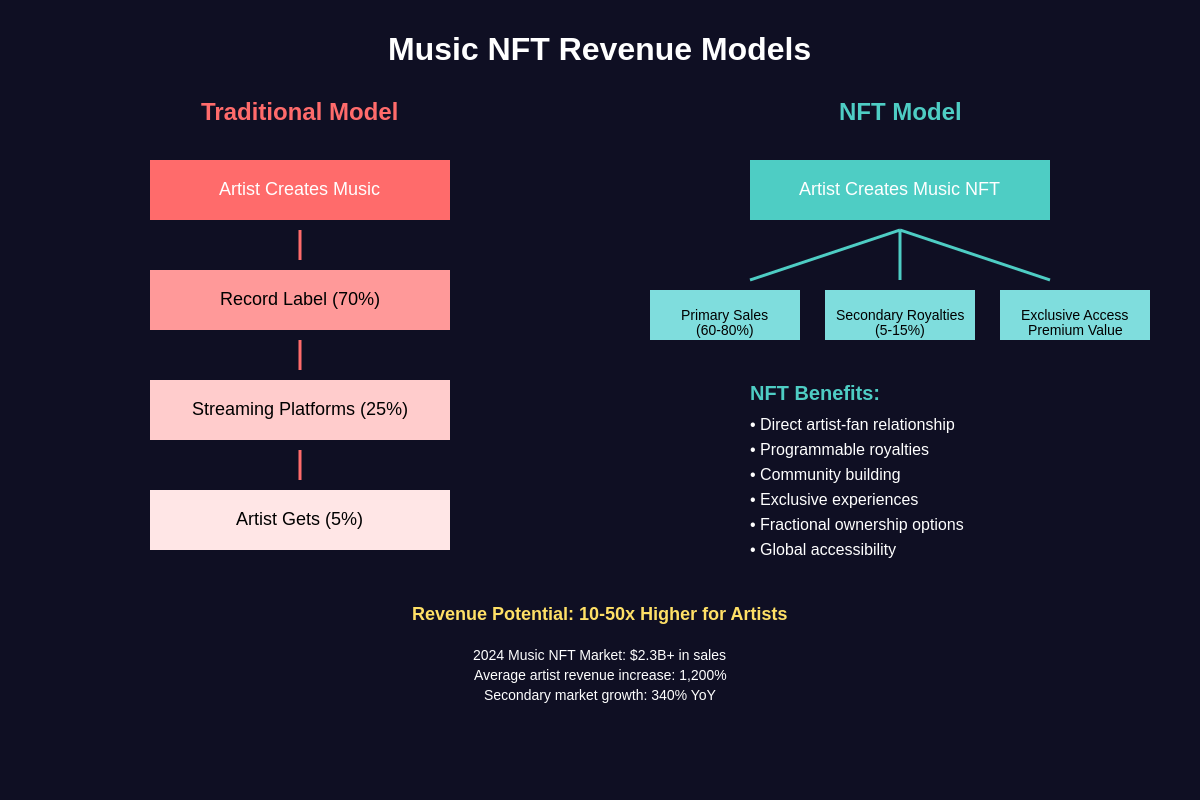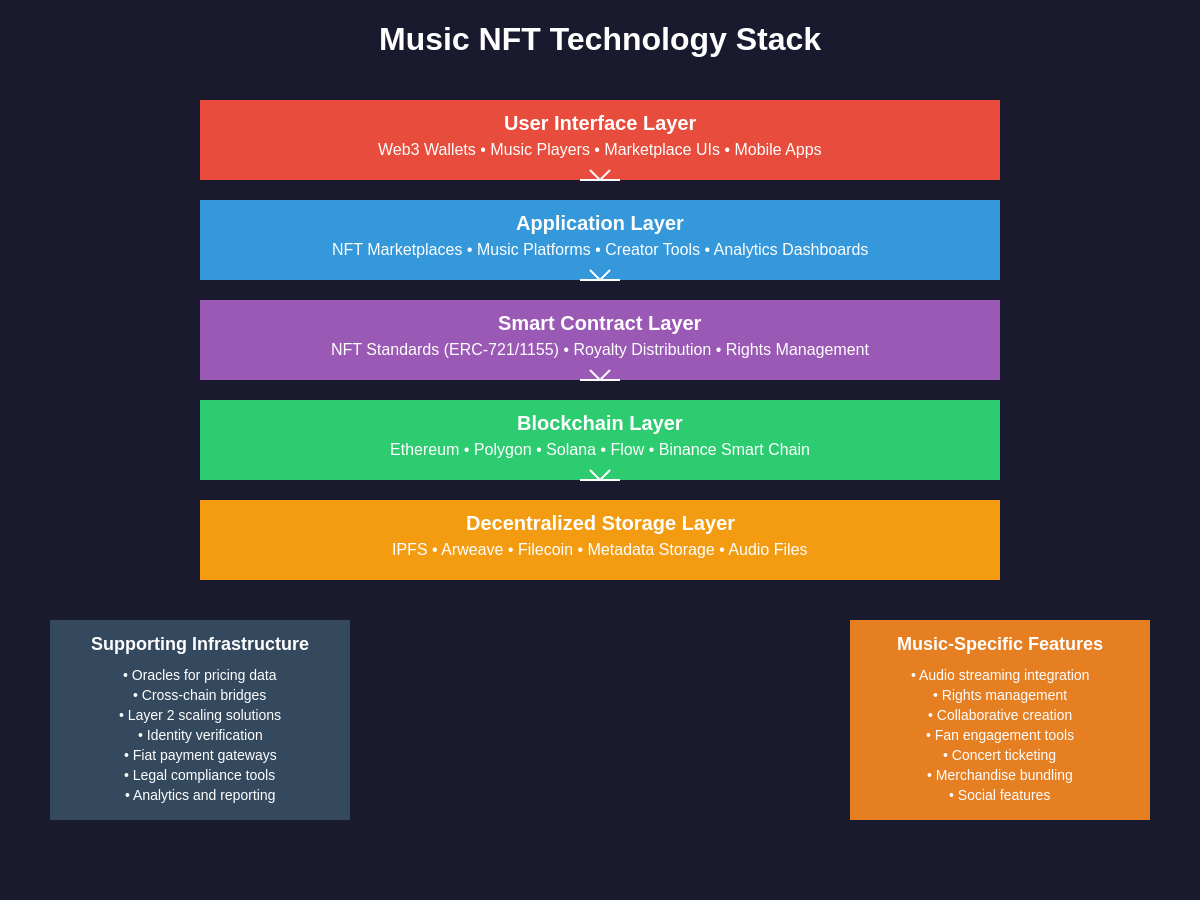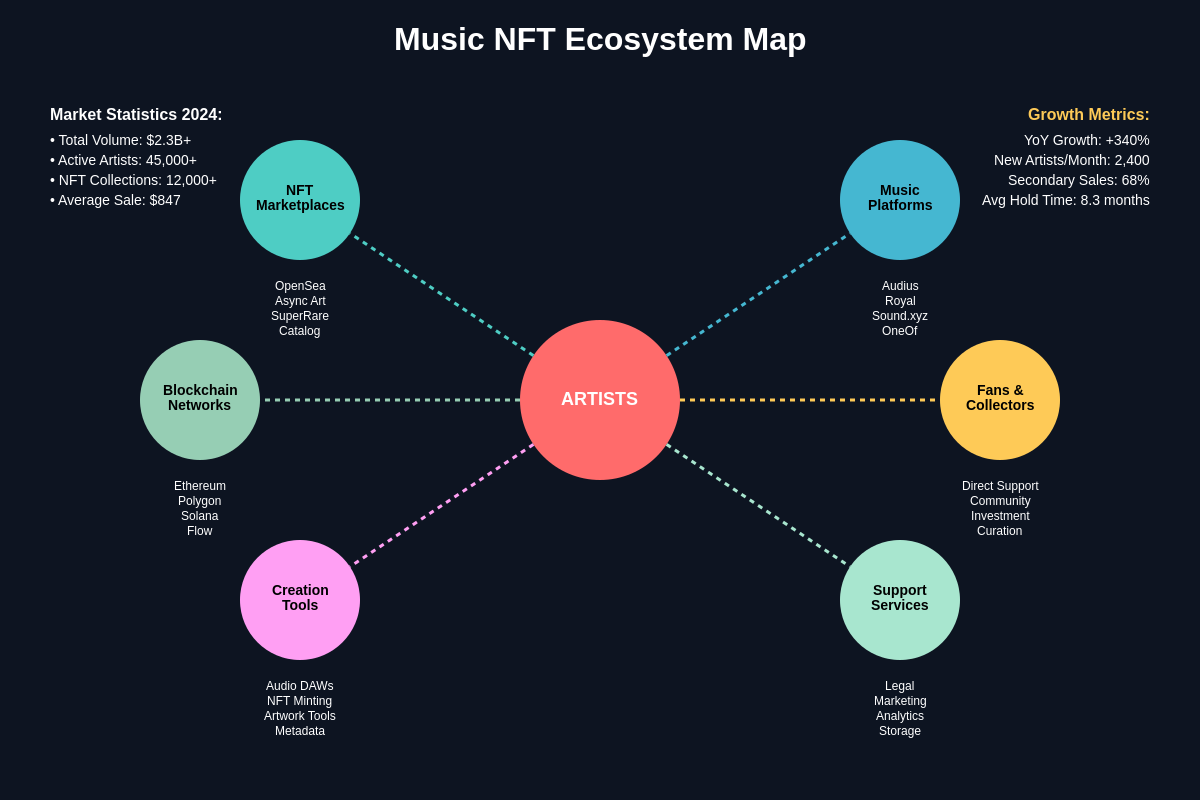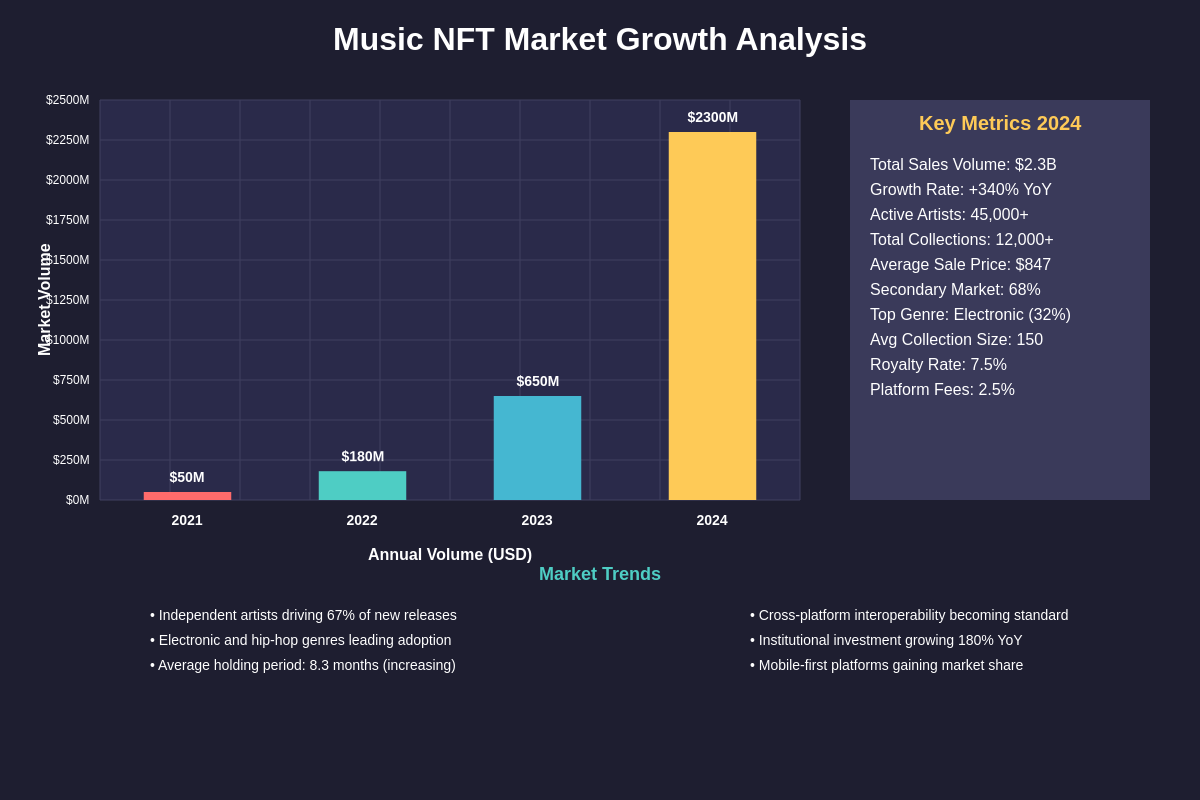Explore advanced music NFT analytics on TradingView
The Revolution in Music Ownership and Distribution

The music industry stands at the precipice of a fundamental transformation as non-fungible tokens revolutionize how artists create, distribute, and monetize their creative works while establishing unprecedented levels of ownership and control over their digital rights. Music NFTs represent far more than simple digital collectibles, embodying a paradigm shift that empowers artists to bypass traditional intermediaries, establish direct relationships with fans, and create new revenue streams that were previously impossible within conventional music distribution systems.
The emergence of music NFTs addresses long-standing issues within the music industry including unfair revenue distribution, lack of artist control over their work, and the dominance of streaming platforms that pay minimal royalties to creators. Through blockchain technology, artists can now tokenize their music, artwork, concert experiences, and even future royalty streams, creating scarce digital assets that fans can own, trade, and potentially profit from while supporting their favorite artists directly.
Traditional Music Industry Challenges and NFT Solutions
The traditional music industry has long been characterized by complex intermediary relationships that often disadvantage artists in favor of record labels, distributors, and streaming platforms. Artists typically receive only a small fraction of revenue generated by their music, with the majority captured by various middlemen who control distribution channels and fan access. This system has persisted for decades despite technological advances that theoretically enable direct artist-to-fan relationships.
Music NFTs fundamentally disrupt this model by enabling artists to mint their music directly on blockchain networks, establishing provable ownership and scarcity while creating programmable smart contracts that automatically distribute royalties according to predetermined terms. When an artist releases a music NFT, they can specify exactly how future sales and royalties will be distributed, potentially including collaborators, producers, and even early supporters in ongoing revenue streams.
The programmable nature of NFT smart contracts enables entirely new business models including dynamic pricing based on secondary market performance, automatic royalty distribution viewable through TradingView’s blockchain analytics, and the ability to bundle music with exclusive experiences, merchandise, or future access rights. These capabilities represent a fundamental evolution beyond traditional music sales or streaming models.
NFT Technology and Music Rights Management
The technical infrastructure underlying music NFTs provides sophisticated solutions for digital rights management that surpass traditional copyright protection mechanisms in both transparency and enforceability. Blockchain-based ownership records create immutable proof of authenticity and ownership history, while smart contracts automate complex licensing agreements and royalty distributions that previously required extensive legal frameworks and ongoing administration.
Music NFTs can encode multiple layers of rights and permissions within their smart contract code, enabling artists to sell different types of access including listening rights, commercial usage rights, remix permissions, and exclusive access to future releases. This granular control over digital rights enables artists to create tiered monetization strategies that cater to different fan segments while maintaining control over how their music is used and distributed.
The interoperability of blockchain networks allows music NFTs to function across multiple platforms and marketplaces, reducing platform lock-in that has historically disadvantaged artists in traditional streaming ecosystems. Artists can mint their music NFTs on one platform while making them available for purchase, trade, and utilization across numerous compatible platforms, increasing exposure and liquidity for their digital assets.
Fan Engagement and Community Building Through Music NFTs
Music NFTs transform the relationship between artists and fans from passive consumption to active participation and investment in an artist’s career trajectory. Fans who purchase music NFTs often receive benefits beyond simple ownership including exclusive access to concerts, behind-the-scenes content, direct communication with artists, and voting rights on creative decisions. This engagement model creates stronger emotional connections and financial alignment between artists and their most dedicated supporters.
The social aspects of music NFT ownership enable new forms of fan community building around shared ownership of rare or exclusive content. NFT holders often form communities where they discuss the artist’s work, share exclusive content, and even collaborate on promotional activities. These communities can become powerful marketing forces that extend an artist’s reach far beyond traditional promotional channels.
Some innovative artists have experimented with collaborative creation models where NFT holders can influence creative decisions, contribute to song writing, or even receive credits on final releases. This participatory approach to music creation represents a fundamental shift from the traditional artist-audience relationship toward more collaborative and democratic creative processes.
Revenue Models and Monetization Strategies
Music NFTs enable artists to implement diverse revenue models that extend far beyond traditional album sales or streaming royalties. Primary sales of music NFTs can generate significant upfront revenue, particularly for artists with dedicated fan bases, while secondary market royalties provide ongoing income streams whenever NFTs are resold. The combination of these revenue streams can provide more stable and predictable income compared to traditional music monetization methods.
Artists can create tiered NFT offerings with different price points and benefits, ranging from affordable editions for casual fans to ultra-rare pieces for serious collectors. This approach maximizes revenue potential while ensuring accessibility across different economic segments of an artist’s fan base. Limited edition releases, exclusive remixes, and special collaborations can command premium prices while building scarcity and collectible value.
The ability to fractionalize ownership of high-value music NFTs enables artists to sell shares of future royalty streams or expensive exclusive content, creating investment opportunities for fans while providing artists with immediate capital. These fractional ownership models can be tracked and analyzed using advanced DeFi analytics available on TradingView, allowing both artists and investors to monitor performance and make informed decisions about music investments.
Blockchain Platforms and Technical Infrastructure

Multiple blockchain networks have emerged as preferred platforms for music NFT deployment, each offering different advantages in terms of transaction costs, environmental impact, and technical capabilities. Ethereum remains the dominant platform for high-value music NFTs due to its robust smart contract capabilities and established marketplace ecosystem, while layer-2 solutions like Polygon offer reduced transaction costs that make smaller music NFT purchases more economically viable.
Specialized music NFT platforms have developed sophisticated tools for audio file storage, metadata management, and complex rights encoding that address the unique requirements of music content. These platforms often integrate with traditional music distribution systems, enabling artists to simultaneously release music as NFTs and through conventional streaming platforms while maintaining synchronized metadata and rights information.
The technical challenges of storing audio files on blockchain networks have led to innovative solutions including decentralized storage networks like IPFS and Arweave, which provide permanent, censorship-resistant hosting for music content. These storage solutions ensure that music NFTs retain their value and functionality even if centralized platforms cease operations, addressing long-term preservation concerns that affect digital music archives.
Legal and Regulatory Considerations
The legal framework governing music NFTs remains complex and evolving, with different jurisdictions taking varying approaches to classification, taxation, and rights enforcement. The intersection of intellectual property law, securities regulation, and digital asset rules creates a challenging landscape that artists, platforms, and collectors must navigate carefully to ensure compliance and protection of their interests.
Copyright considerations become particularly complex when dealing with music NFTs, as the token ownership does not automatically convey copyright ownership unless explicitly stated in the smart contract terms. Artists must clearly define what rights are being transferred with NFT ownership to avoid legal disputes and ensure that collectors understand exactly what they are purchasing beyond the token itself.
International rights management becomes even more complex in the NFT space, as blockchain networks operate across jurisdictional boundaries while music rights are typically managed through territorial licensing agreements. Artists and platforms must develop new frameworks for international rights management that account for the borderless nature of blockchain networks while respecting existing international copyright treaties and agreements.
Major Artists and Case Studies
Several high-profile artists have successfully launched music NFT projects that demonstrate the potential of this new medium while providing valuable insights into best practices and common pitfalls. Kings of Leon’s “When You See Yourself” album NFT release generated over $2 million in sales while providing holders with exclusive perks including front-row concert seats and special album artwork, demonstrating how established artists can leverage their existing fan base for NFT success.
Electronic music artists have been particularly successful with music NFTs due to the technical compatibility between electronic music production and digital art creation. Artists like 3LAU, Deadmau5, and Grimes have generated millions of dollars in NFT sales while pioneering new formats that combine music with visual art, interactive experiences, and exclusive access rights that extend far beyond traditional music sales.
Independent artists have found particular success with music NFTs as they provide direct monetization opportunities without requiring label support or significant marketing budgets. Emerging artists can build dedicated fan communities around limited NFT releases while retaining full control over their creative output and revenue streams, representing a democratization of music industry success that was previously difficult to achieve.
Market Dynamics and Collector Behavior

The music NFT market exhibits unique characteristics that distinguish it from other NFT categories including stronger emotional connections between collectors and content, longer holding periods due to sentimental value, and less speculative trading behavior focused primarily on artistic speculation rather than financial returns. These dynamics create more stable market conditions that benefit both artists and long-term collectors.
Collector behavior in music NFT markets tends to be influenced by factors including artist reputation, scarcity of releases, and the exclusivity of associated benefits rather than purely speculative considerations. This creates opportunities for artists to build sustainable businesses around their NFT releases by focusing on genuine value creation for their communities rather than relying on speculative trading volume.
Secondary market dynamics for music NFTs often reflect the ongoing career trajectory of artists, with successful new releases, concert tours, and media coverage positively impacting the value of earlier NFT releases. This correlation between artistic success and NFT performance can be analyzed using comprehensive market data available through TradingView’s NFT tracking tools, enabling collectors to make more informed investment decisions based on artistic fundamentals rather than pure speculation.
Impact on Music Distribution and Streaming
Music NFTs are beginning to influence traditional music distribution channels as streaming platforms and distributors adapt to accommodate blockchain-based releases and rights management. Some platforms are exploring integration with NFT marketplaces to enable seamless cross-platform functionality, while others are developing their own NFT capabilities to retain artists who might otherwise migrate to blockchain-native platforms.
The coexistence of NFT releases and traditional streaming raises interesting questions about exclusivity, timing, and pricing strategies that artists must consider when planning their release schedules. Some artists choose to release NFT versions with exclusive content or early access before making music available on streaming platforms, while others simultaneously release across all channels to maximize reach and revenue.
The data and analytics available through blockchain networks provide artists with unprecedented insights into their audience behavior, purchasing patterns, and geographic distribution that surpass the limited analytics provided by traditional streaming platforms. This enhanced data visibility enables more sophisticated marketing strategies and audience development approaches that can benefit an artist’s overall career trajectory.
Challenges and Limitations
Despite the significant potential of music NFTs, several challenges limit their widespread adoption including high transaction costs on popular blockchain networks, complex user experience requirements for non-technical fans, and limited mainstream awareness of NFT technology and benefits. These barriers particularly affect smaller artists and their fan bases who may lack the technical knowledge or financial resources to participate effectively in NFT markets.
Environmental concerns related to blockchain network energy consumption have created resistance among environmentally conscious artists and fans, though the migration to proof-of-stake networks and layer-2 solutions is addressing these concerns. Artists must carefully consider the environmental impact of their chosen blockchain platform and communicate their environmental commitments to maintain credibility with their audience.
The volatility of cryptocurrency markets affects music NFT accessibility and value stability, as prices denominated in cryptocurrency can fluctuate significantly based on broader market conditions unrelated to the music content itself. This volatility can create barriers to mainstream adoption while complicating financial planning for artists who rely on NFT sales for income.
Future Trends and Technological Development
Emerging technologies including artificial intelligence, virtual reality, and augmented reality are beginning to integrate with music NFTs to create immersive experiences that extend far beyond traditional audio content. AI-generated music NFTs, VR concert experiences tied to token ownership, and AR-enabled album artwork represent the next evolution of music NFT functionality that could drive broader adoption and higher value creation.
The development of music-specific blockchain networks optimized for audio content, royalty distribution, and rights management could address many current limitations while providing enhanced functionality tailored specifically to music industry requirements. These specialized networks could offer lower transaction costs, better user experiences, and more sophisticated rights management capabilities than general-purpose blockchain platforms.
Cross-platform interoperability and standardization efforts aim to create seamless experiences where music NFTs purchased on one platform can be accessed, displayed, and utilized across multiple compatible applications and marketplaces. This interoperability could significantly increase the utility and value of music NFTs while reducing platform lock-in that currently limits market development.
Industry Partnerships and Institutional Adoption
Major music industry stakeholders including record labels, publishing companies, and collection societies are beginning to explore NFT integration as a complement to existing business models rather than a replacement. These partnerships could accelerate mainstream adoption while ensuring that NFT developments remain compatible with existing rights management and distribution infrastructure.
Institutional investors and music industry funds are beginning to allocate capital to music NFT acquisitions and platform development, providing the financial resources necessary for large-scale market development and artist support programs. This institutional involvement could provide stability and legitimacy that encourages broader participation from both artists and collectors.
Educational initiatives aimed at music industry professionals, artists, and fans are crucial for driving adoption by reducing technical barriers and misconceptions about NFT technology. Industry organizations, blockchain platforms, and educational institutions are developing comprehensive programs that explain both the opportunities and risks associated with music NFT participation.
Global Market Development and Cultural Impact

Music NFTs are developing differently across global markets based on local cryptocurrency adoption, regulatory environments, and cultural attitudes toward digital ownership. Asian markets have shown particularly strong adoption due to existing familiarity with digital collectibles and mobile payment systems, while Western markets are focusing more on rights management and artist empowerment applications.
The cultural impact of music NFTs extends beyond financial considerations to include questions about the nature of music ownership, the value of scarcity in digital content, and the relationship between technology and artistic expression. These cultural discussions influence adoption rates and market development across different demographic segments and geographic regions.
Emerging markets present significant opportunities for music NFT adoption as they often lack well-developed traditional music industry infrastructure, making blockchain-based alternatives more attractive for both artists and fans. The global nature of blockchain networks enables artists in emerging markets to access international audiences and collectors without requiring traditional export infrastructure or international distribution agreements.
The transformation of the music industry through NFT technology represents one of the most significant disruptions since the advent of digital streaming, fundamentally altering the relationship between artists, fans, and the broader music ecosystem. As artists gain unprecedented control over their digital rights and revenue streams, the traditional power structures that have dominated the music industry for decades are being challenged and reimagined through blockchain technology.
The success of music NFTs ultimately depends on continued technological development, regulatory clarity, and widespread adoption by both artists and fans who recognize the value of direct ownership relationships and community participation in artistic endeavors. While challenges remain regarding accessibility, environmental impact, and market volatility, the fundamental benefits of artist empowerment and fan engagement suggest that music NFTs will continue to evolve and gain significance within the broader music industry ecosystem.
The future of music NFTs lies not in replacing traditional music distribution entirely, but in creating complementary systems that provide artists with additional tools for creative expression, community building, and sustainable monetization while offering fans new ways to support and engage with their favorite artists. As the technology matures and user experiences improve, music NFTs have the potential to democratize the music industry while preserving the artistic integrity and creative freedom that drive musical innovation.
Disclaimer: This article is for informational purposes only and does not constitute investment advice. Music NFTs and cryptocurrency investments carry significant risks including total loss of capital. The music NFT market is highly speculative and volatile. Past performance does not guarantee future results. Readers should conduct thorough research and consider their risk tolerance before participating in music NFT markets. Cryptocurrency regulations vary by jurisdiction and may change rapidly. Always consult with qualified financial and legal professionals before making investment decisions involving digital assets or NFTs.